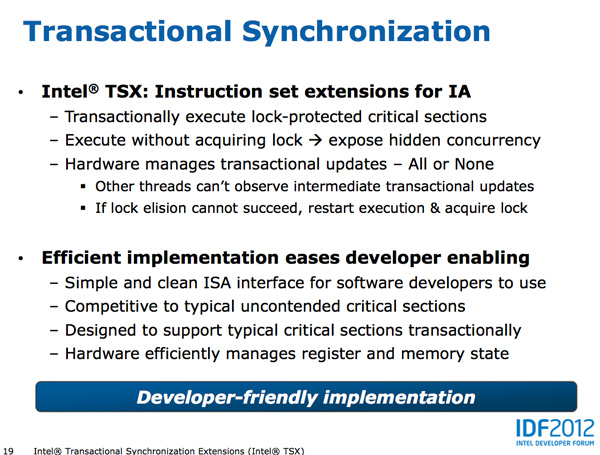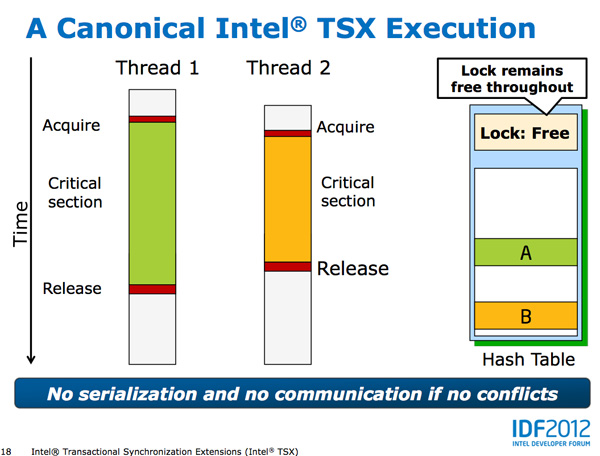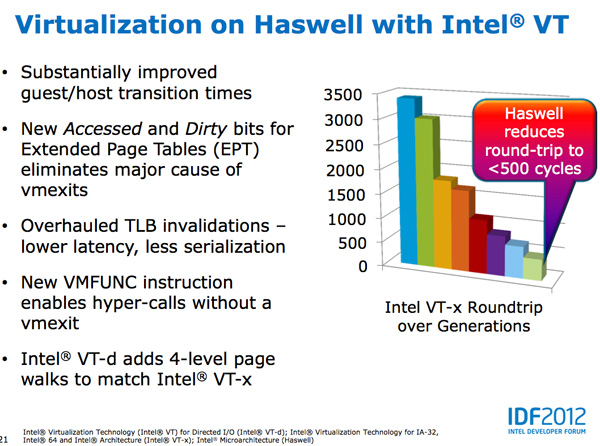Intel's Haswell Architecture Analyzed: Building a New PC and a New Intel
by Anand Lal Shimpi on October 5, 2012 2:45 AM ESTTSX
Johan did a great job explaining Haswell's Transactional Synchronization eXtensions (TSX), so I won't go into as much depth here. The basic premise is simple, although the implementation is quite complex.
It's easy to demand well threaded applications from software vendors, but actually implementing code that scales well across unlimited threads isn't easy. Parallelizing truly independent tasks is the low hanging fruit, but it's the tasks that all access the same data structure that can create problems. With multiple cores accessing the same data structure, running independent of one another, there's the risk of two different cores writing to the same part of the same structure. Only one set of data can be right, but dealing with this concurrent access problem can get hairy.
The simplest way to deal with it is simply to lock the entire data structure as soon as one core starts accessing it and only allow that one core write access until it's done. Other cores are given access to the data structure, but serially, not in parallel to avoid any data integrity issues.
This is by far the easiest way to deal with the problem of multiple threads accessing the same data structure, however it also prevents any performance scaling across multiple threads/cores. As focused as Intel is on increasing single threaded performance, a lot of die area goes wasted if applications don't scale well with more cores.
Software developers can instead choose to implement more fine grained locking of data structures, however doing so obviously increases the complexity of their code.
Haswell's TSX instructions allow the developer to shift much of the complexity of managing locks to the CPU. Using the new Hardware Lock Elision and its XAQUIRE/XRELEASE instructions, Haswell developers can mark a section of code for transactional execution. Haswell will then execute the code as if no hardware locks were in place and if it completes without issues the CPU will commit all writes to memory and enjoy the performance benefits. If two or more threads attempt to write to the same area in memory, the process is aborted and code re-executed traditionally with locks. The XAQUIRE/XRELEASE instructions decode to no-ops on earlier architectures so backwards compatibility isn't a problem.
Like most new instructions, it's going to take a while for Haswell's TSX to take off as we'll need to see significant adoption of Haswell platforms as well as developers embracing the new instructions. TSX does stand to show improvements in performance anywhere from client to server performance if implemented however, this is definitely one to watch for and be excited about.
Haswell also continues improvements in virtualization performance, including big decreases to guest/host transition times.














245 Comments
View All Comments
Astarael - Monday, October 15, 2012 - link
Then get out of the comments section.Old_Fogie_Late_Bloomer - Tuesday, October 9, 2012 - link
I finally made it through this article...hell, I took a course in orgnization and architecture earlier this year and I didn't come close to understanding everything written here.Still, it was a great read. Thanks for going to the trouble, Anand. :-)
IKeelU - Friday, October 5, 2012 - link
What's great is that Anand's been doing this for 15 years, has hired new editors along the way, and the quality hasn't wavered. I'm glad they haven't polluted their front page with shallow tech blogging like other sites I once enjoyed.I can't imagine this hobby without this site. I got into PC building just as it came online and have depended on it ever since.
TheJian - Monday, October 8, 2012 - link
I disagree. Ryan Smith's 660TI article had some ridiculous conclusions and went on and on about a bandwidth issue that isn't an issue at 1920x1200. As evidenced by the fact that in their own tests it beat the 7950B in 6 games by OVER 20% but lost in one game by less than 10 at 1920x1200. Read the comments section where I reduced his arguments to rubble. He went on about a dumb Korean monitor you'd have to EBAY to get (or amazon from a guy with ONE review, no phone, no faq page, no domain, and a gmail account for help...LOL), and runs in 2560x1440. If his conclusions were based on 1920x1200 like he said (which he repeated to me in the comments yet touts some "enthusiast 2560x1440" korean monitor as an excuse for his conclusions), he would have been forced to say the truth which was as his benchmarks showed and hardocp stated. It wipes the floor with the 7950B, just as the 680 does with the 7970ghz (yea, even in MSAA 8x) where they also proved only 1 in 4 games was even above 30fps...@2560x1600 with high AA which is why its pointless to draw conclusions based on 2560x1600 as Ryan did. Heck 2 of the 4 games at hardocp's high AA article didn't even reach above 20fps (15 & 17, and if bandwidth is an issue how come the 660TI won anyway?...LOL)Ryan was reduced to being a fool when I was done with him, and then Jarred W. came in and insinuated I was a Ahole & uninformed...ROFL. I used all of his own data from the 660TI & 7970B & 7970ghz edition articles (all by Ryan!) to point out how ridiculous his conclusions were. When a card loses 6 out of 7 games, you leave out Starcraft 2 (which you used for 2 previous articles 1 & 2 months before, then again IMMEDIATELY after) which would have shown it beating even the 7970ghz edition (as all the nv cards beat it in that game, hence he left it out), you claim some Korean Ebay'd monitor as a reason for your asinine conclusions (clear bias to me), in the 6 games it loses by an avg of 20% or more at the ONLY res 68 24in monitors on newegg use (or below, most 1920x1080, not even 1920x1200, only <2% in steampowered.com hardware survey have above 1920x1200 and most with dual cards in that case), you've clearly WAVERED in your QUALITY since Anand took up mac's/phones.
I'm all for trying to save AMD (quit lowering your prices idiots, maybe you'll make some money), but stooping to dumb conclusions when all of your own evidence points in the exact opposite direction is really shady. Worse it was BOTH editors, as Ryan gave up (the evidence was voluminous, he wisely ran and hid) Jarred stepped in to personally attack me instead of the data...ROFLMAO. You know you've lost when you say nothing about my numbers at all, and resort to personal attacks. Ryan nor Jarred are dumb. They should have just admitted the article was full of bias or just changed the conclusion and moved on. With all the evidence I pointed out I wouldn't have wanted it to be in print any longer. It's embarrassing if you read the comments section after the article. You go back and realize what they did and wonder what the heck Ryan was thinking. He said that same crap in his next article. Either he loves AMD, gets money/hardware or something or maybe he just isn't as smart as I thought :)
Anand's last hardware article on haswell said it would be a "MONSTER" but it's graphics won't catch AMD's integrated gpu and we only get 5-15% on the cpu side for a TOCK release. 2x gpu doesn't mean much with it being 9 months away and won't even catch AMD if they sit still. OUCH. So basically much ado about nothing on the desktop side, with a hope they can do something with it in mobile below 10w (only a tablet even then). I was pondering waiting for the "MONSTER" but now I know I'll just buy an Ivy at black friday...ROFL. What monster? In this article he says Broadwell is now the "monster"...heh. Bah...At least I got to read this before black friday. I would have been ticked had I read this after it hoping for the desktop monster. Since AMD now sucks on the cpu side we get speed bin bumps for microarchitecure TOCK's instead of 25-40% like the old days. I pray AMD stops the price war with NV and starts taking profits soon.
If it wasn't for their advantage on the integrated gpu, they'd be bankrupt already and they will be there by xmas 2014 at the current burn of 650mil/year losses (they only have 1.5Bil in the bank and billions in debt compared to 3.5B cash for NV and no debt, never mind giving up the race to Intel who dwarfs NV by 10x on all fronts). AMD's only choice will be to further reduce their stock value by dilution of shares (AGAIN!) which will finally put them out to pasture. Hopefully someone will pick up their IP, put a few billion in it and compete again with Intel (samsung, ibm, NV if amd stock drops to $1 by then, even they could do it). Otherwise, my next card/cpu upgrade after black friday will cost $1000 each as NV/INTC suck us all dry. There stock is already WAY down in credit rating (B+ last I checked, FAR from NV AAA), and they are listed as 50% chance of bankruptcy vs. all their competitors at 1% chance (intc, qcom, nvda, samsung etc). The idea they'll take over mobile is far fetched at best. I see nowhere but down for their share price. That sucks. I hate apple, but at this point I wouldn't even mind if they picked them up and ran with AMD's cpu mantle. We might start getting ivy 3770's (or the next king) at prices less than $329 then! The first sale I've seen was $309 in my email from newegg this weekend and that sucks in 7 months. No speed upgrades, no price drops, just the same thing for 7 months with no pressure from a competitive-less AMD. Their gpu sucks compared to 660ti (hotter, noisy, less perf), so no black friday discount. You either go AMD for worse but savings or pay through the nose for NV. Same with Intel and the cpu. In that respect I guess I get Ryan trying to save them...ROFL. But prolonging the inevitable isn't helping, I'd rather have them go belly up now and someone buy the cpu and run with it before it's so far behind Intel they can't fix it no matter who buys the IP. I digress...
Spunjji - Thursday, October 18, 2012 - link
God that was painful to even attempt to read. :/ Comparing AMD vs. nVidia to AMD vs. Intel is foolish in the extreme (there's a rather significant difference in the cost/performance balance, where AMD and nVidia are actually competitors) so I feel justified in not reading most of that screed.ananduser - Friday, October 5, 2012 - link
Yes...Anand's quite the loss for the PC crowd. He's reviewing macs nowadays.A5 - Friday, October 5, 2012 - link
If you owned a site and could delegate reviews you don't find interesting (oooh boy, another 15-pound overpriced gaming laptop!), wouldn't you do the same thing?Kepe - Friday, October 5, 2012 - link
Mmh, I've also noticed how Anand seems to have become quite an Apple fan. Don't get me wrong, I love his reviews, and Anandtech as a whole. But the fact that Anand always keeps talking about Apple is an eyesore to me. Particularly annoying in this article was how he mentioned "iPad form factor" as if it was the only tablet out there. Why not say "tablet form factor" instead? Would have been a lot more neutral. Also it seemed to confuse someone in to thinking Apple might be putting Haswell in to a new iPad.meloz - Friday, October 5, 2012 - link
Agreed. The Apple devotion has gone too far and the editorial balanced has been lost. The podcasts -in particular- are basically an advertising campaign for Apple and a thinly disguised excuse for Anand & Friends to praise everything Apple. So I do not listen to them.The articles though -like this one about Haswell- are still worth reading. You still get as much gratuitous Apple references as Anand can throw in but there is also plenty of substance for everyone else.
ravisurdhar - Friday, October 5, 2012 - link
It's not "devotion", it's simply an accurate description of the market. How many iPads are out there? 100 million. One tenth of a BILLION. One for every 70 people on the planet. Well over half of Fortune 500 companies use them. Hospitals use them. Pilots use them. Name one other tablet that comes close to that sort of market penetration. When Apple decides to make their own silicon for their devices, it's a big, big deal.For the record, I don't have one. I just understand the significance of the 800 pound gorilla.